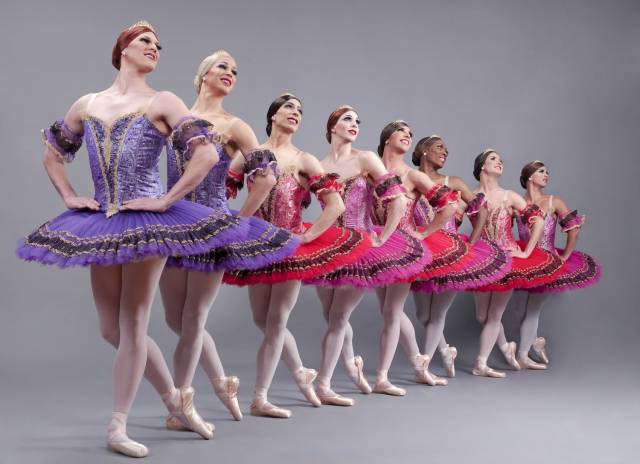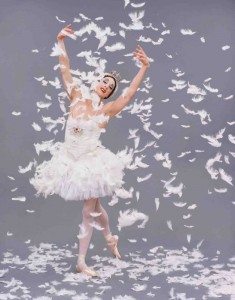

When you go to a performance from Les Ballets Trockadero de Monte Carlo, you can expect humor right off the bat: the curtain speech includes a haughty Russian voice dramatically listing changes to the evening's program "in true Russian Ballet fashion" and dramatic reasons why you should not use your cell phone during the performance. There are two programs in this run at the Joyce (both A and B consist of the Trocks' most popular works). Program A includes E Lac Des Cygnes (Swan Lake, Act II), Go For Barocco, and the New York Premiere of La Naiade et le Pecheur. I had the privilege to enjoy Program B, which included ChopEniana, Patterns in Space, "Pas De Six" from Esmeralda, and Don Quixote.
Why do we love the Trocks so much? It's not just that it's comedy, a drag show, and ballet combined; it's because it is so refreshing. Anyone -- even those who know nothing about ballet -- can enjoy this company, which strips ballet of its seriousness, ideal physiques, and its demand on the audience to "get it." What the Trocks keep is the technique; what they add is personality and humor. Instead of watching a group of rail-thin ballerinas, who all kind of look (and dance) alike, we see a group of ballerinas of different shapes, sizes, and colors -- some with chest hair! The Trocks allow you to see another side of ballet -- another world that is human and fallible.
ChopEniana opened the show with quick wit and slap stick-like humor. As a Ballet Blanc, this number is abstract, yet Romantic and, like a dream world (gone awry), the dancers float whimsically over the stage in their flowing, white, knee length tutus only to fall down, knock another in the face with a gorgeous attitude turn, or fall off the stage completely! Patterns in Space winks and smiles at the dynamic duo of Merce Cunningham and John Cage and their adherence to chance and random phenomena to determine structure. The dancers’ movement is hilarious as they quickly change direction, explore angles, fall into a deep plie, exit the stage, and remain serious — no smiles, no expression, just movement. Even funnier are the musicians (Lariska Dumbchenko and Yuri Smirnov) who use inane props as instrumentation. They include but are not limited to: brown paper bags that are crumpled, uncrumpled again and again and eventually popped in unison; an electric razor accompanied by a squirt bottle and the snipping of scissors; and Dumbchenko, slowly turning around in her chair, placing her legs on the back of the chair, and lying back with her face under the microphone only to gargle water! “Pas de Six” from Esmeralda is an excerpt from a three act ballet based upon Victor Hugo’s Notre Dame de Paris. Choreographed after the great Marius Petipa, this number is fun with big haired wigs and decorated tambourines that are moved and shaked enough that they seems like characters themselves. Here we get a wonderful blend in focus from intricate ballet technique, comedy, and narrative.

The ever popular Dying Swan, was not listed in the program, but it was announced during the curtain speech that Ida Nevasayneva would consent to perform it. This piece is perhaps one of the most intelligent comments on the dancer’s experience as an aging performer. It explores, not without humor, how the body transforms as it ages and starts to have a mind of its own. Nevasayneva performs this piece so beautifully and with expert timing drifts in between elegant and clumsy movements. Following Nevasayneva and concluding the evening’s performance was an amazing rendition of Don Quixote. This ballet offers the most subtle humor and allows for the audience to focus more intently on the movement and narrative. The technical aspects are amped up for this piece and executed pristinely. Many times, I forgot that the lead played by Yakatarina Verosovich is not a female ballet dancer! Verosovich (Chase Johnsey) is so fabulous that the audience can’t help but fall in love with her character, charisma, poise, and immense talent. Every number, but perhaps this one in particular, reminds you of the tremendous work and dedication these performers have. We see and join them in the great respect this company has for the art of dance.